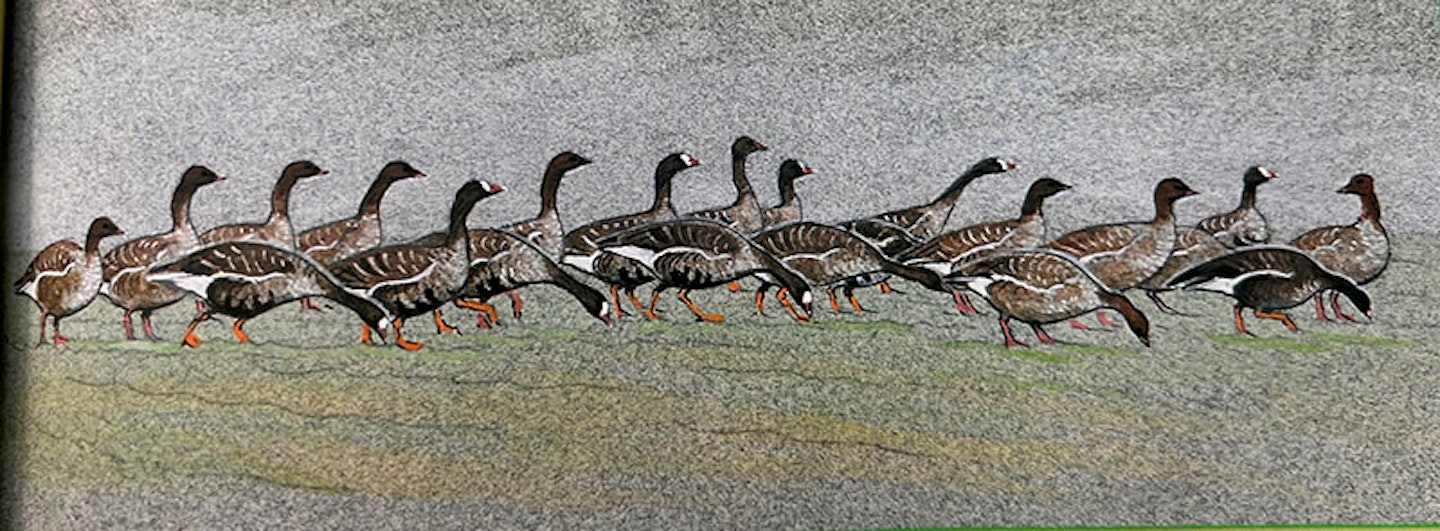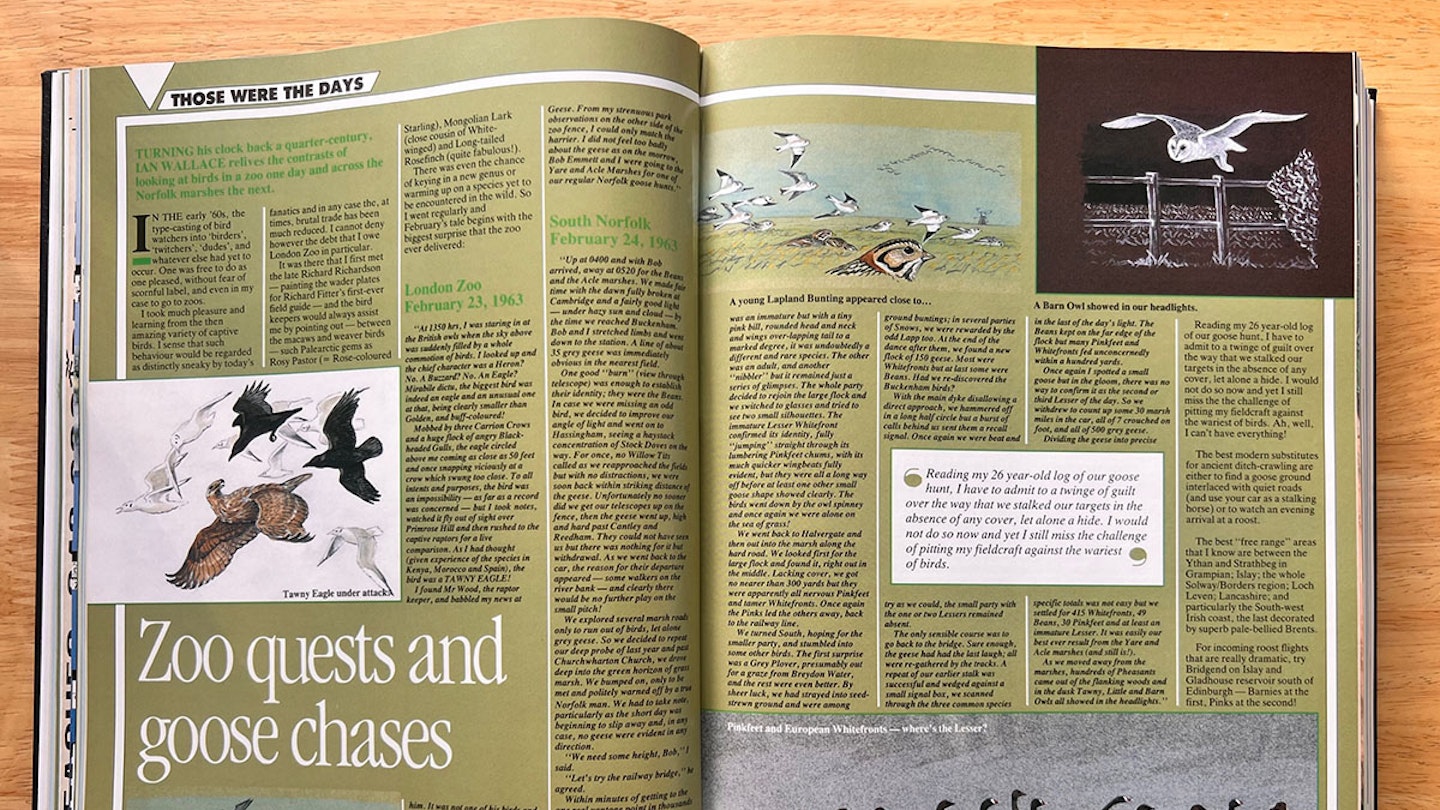Zoo quests and goose chases
February 1990

Turning his clock back a quarter-century Ian Wallace relives the contrasts of looking at birds in a zoo one day and across the Norfolk marshes the next.
In the early 1960s, the type-casting of birdwatchers into birders’, ‘twitchers’, dudes’ and whatever else, had yet to occur. One was free to do as one pleased, without fear of scornful label, and even in my case to go to zoos.
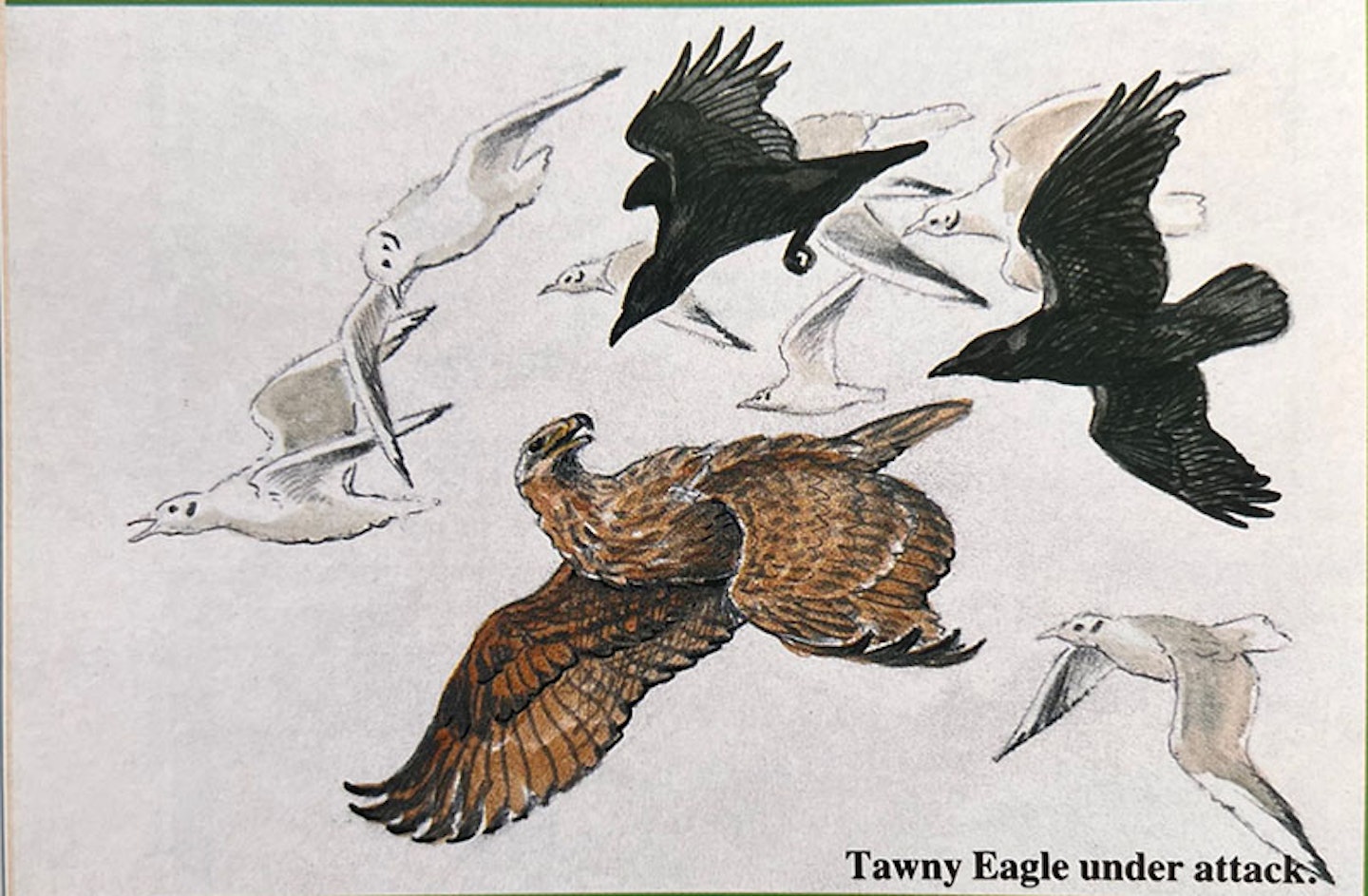
I took much pleasure and learning from the then amazing variety of captive birds. I sense that such behaviour would be regarded as distinctly sneaky by today’s fanatics and in any case the, at times, brutal trade has been much reduced. I cannot deny however the debt that I owe London Zoo in particular. It was there that I first met the late Richard Richardson painting the wader plates for Richard Fitter’s first-ever field guide and the bird keepers would always assist me by pointing out – between the macaws and weaver birds – such Palearctic gems as Rosy Pastor (= Rose-coloured Starling), Mongolian Lark (close cousin of White-winged) and Long-tailed Rosefinch (quite fabulous!).
There was even the chance of keying in a new genus or warming up on a species yet to be encountered in the wild. So I went regularly and February’s tale begins with the biggest surprise that the zoo ever delivered:
London Zoo, 23 February, 1963
At 1350 hrs, I was staring in at the British owls when the sky above was suddenly filled by a whole commotion of birds. I looked up and the chief character was a heron? No. A Buzzard? No. An eagle? Mirabile dictu, the biggest bird was indeed an eagle and an unusual one at that, being clearly smaller than Golden, and buff-coloured!
Mobbed by three Carrion Crows and a huge flock of angry Black-headed Gulls, the eagle circled above me coming as close as 50 feet and once snapping viciously at a crow which swung too close. To all intents and purposes, the bird was an impossibility – as far as a record was concerned – but I took notes, watched it fly out of sight over Primrose Hill and then rushed to the captive raptors for a live comparison.

As I had thought (given experience of the species in Kenya, Morocco and Spain), the bird was a Tawny Eagle! I found Mr Wood, the raptor keeper, and babbled my news at him. It was not one of his birds and I had to agree that his suggestion of an escape from Palmer’s –the then amazing “any pet you like, up to crocodile” shop in nearby Camden Town – made sense.
Whatever its origins, the eagle had provided me with a marvellous sight for Inner London Talking on with the keeper, I learnt that the zoo’s captive raptors often spotted their wild brethren in the sky. Following their upwards glances had put Mr Wood onto Montagu’s Harrier, Buzzard and Peregrine and even passing skeins of Pink-footed and White-fronted Geese.
From my strenuous park observations on the other side of the zoo fence, I could only match the harrier. I did not feel too badly about the geese as on the morrow, Bob Emmett and I were going to the Yare and Acle Marshes for one of our regular Norfolk goose hunts.
South Norfolk, 24 February 24 1963
Up at 0400 and with Bob arrived, away at 0520 for the Beans and the Acle marshes. We made fair time with the dawn fully broken at Cambridge and a fairly good light – under hazy sun and cloud – by the time we reached Buckenham. Bob and I stretched limbs and went down to the station.
A line of about 35 grey geese was immediately obvious in the nearest field. One good “burn” (view through telescope) was enough to establish their identity: they were the Beans. In case we were missing an odd bird, we decided to improve our angle of light and went on to Hassingham, seeing a haystack concentration of Stock Doves on the way.
For once, no Willow Tits called as we reapproached the fields but with no distractions, we were soon back within striking distance of the geese. Unfortunately no sooner did we get our telescopes up on the fence, then the geese went up, high and hard past Cantley and Reedham. They could not have seen us but there was nothing for it but withdrawal. As we went back to the car, the reason for their departure appeared – some walkers on the river bank – and clearly there would be no further play on the small pitch!
We explored several marsh roads only to run out of birds, let alone grey geese. So, we decided to repeat our deep probe of last year and past Churchwharton Church, we drove deep into the green horizon of grass marsh. We bumped on, only to be met and politely warned off by a true Norfolk man. We had to take note, particularly as the short day was beginning to slip away and, in any case, no geese were evident in any direction.
“We need some height, Bob,” I said. “Let’s try the railway bridge,” he agreed. Within minutes of getting to the one real vantage point in thousands of acres, we had spotted a large flock of geese north of the railway line and were off after it. With careful stalking and using the railway posts and wire to break our silhouettes (a wee bit!), we got close to a flank party and the main group.
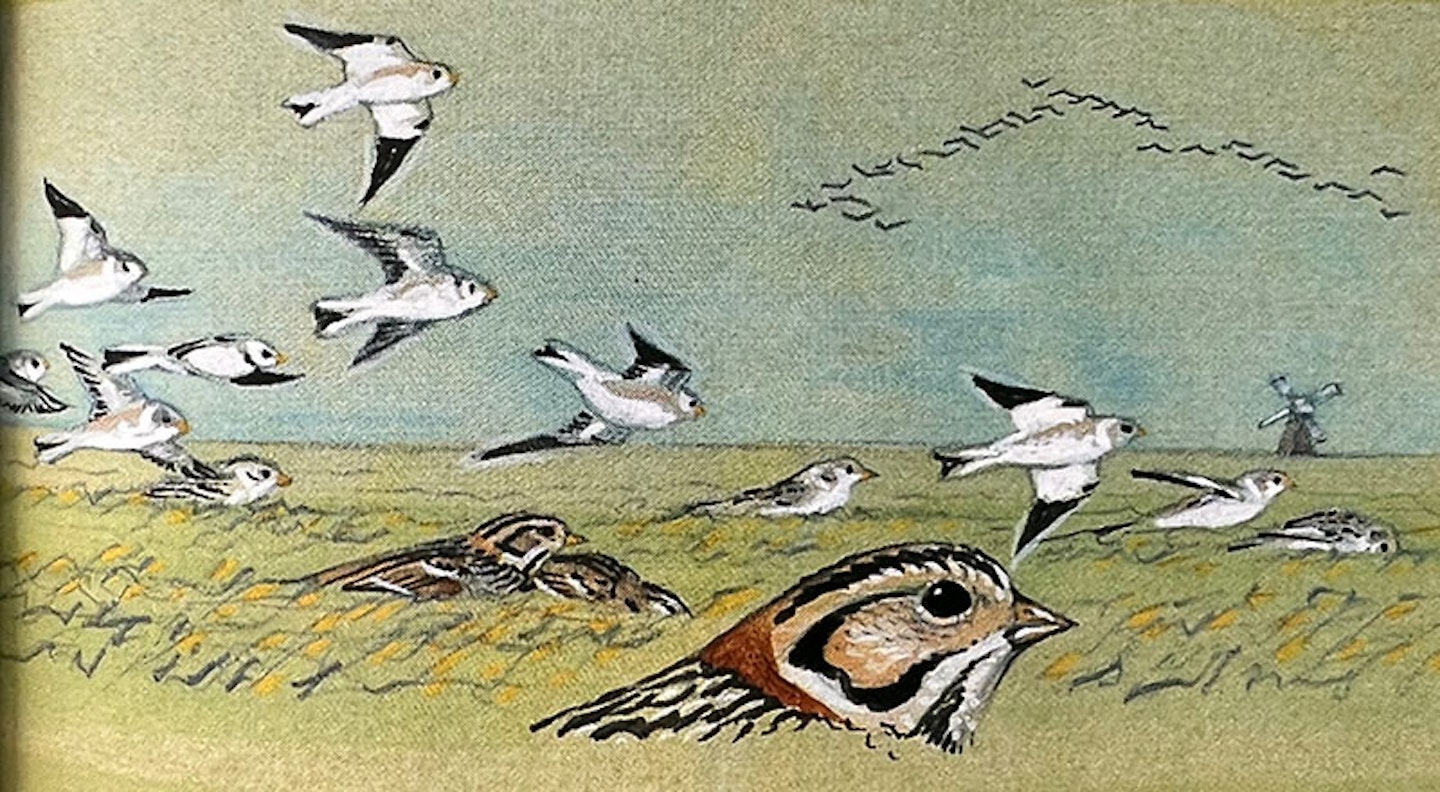
The latter, a mix of Pinkfeet and Whitefronts, was off as soon as our heads showed, but the former remained. We “burnt” it hard and got it sorted into five Pinkfeet, 30 Whitefronts and two smaller Whitefronts. Because of their positions, we could see only one of the last well. It was an immature but with a tiny pink bill, rounded head and neck and wings over-lapping tail to a marked degree, it was undoubtedly a different and rare species. The other was an adult, and another “nibbler” but it remained just a series of glimpses.
The whole party decided to rejoin the large flock and we switched to glasses and tried to see two small silhouettes. The immature Lesser Whitefront confirmed its identity, fully “jumping” straight through its lumbering Pinkfeet chums, with its much quicker wingbeats fully evident, but they were all a long way off before at least one other small goose shape showed clearly.
The birds went down by the owl spinney and once again we were alone on the sea of grass! We went back to Halvergate and then out into the marsh along the hard road. We looked first for the large flock and found it, right out in the middle. Lacking cover, we got no nearer than 300 yards but they were apparently all nervous Pinkfeet and tamer Whitefronts.
Once again the Pinks led the others away, back to the railway line. We turned south, hoping for the smaller party, and stumbled into some other birds. The first surprise was a Grey Plover, presumably out for a graze from Breydon Water, and the rest were even better. By sheer luck, we had strayed into seed-strewn ground and were among ground buntings; in several parties of Snows, we were rewarded by the odd Lapp, too.
At the end of the dance after them, we found a new flock of 150 geese. Most were Whitefronts, but at last some were Beans. Had we re-discovered the Buckenham birds?
With the main dyke disallowing a direct approach, we hammered off in a long half circle but a burst of calls behind us sent them a recall signal. Once again we were beaten and try as we could, the small party with the one or two Lessers remained absent.
The only sensible course was to go back to the bridge. Sure enough, the geese had had the last laugh; all were re-gathered by the tracks. A repeat of our earlier stalk was successful and wedged against a small signal box, we scanned through the three common species in the last of the day’s light. The Beans kept on the far edge of the flock but many Pinkfeet and Whitefronts fed unconcernedly within a hundred yards.
Once again I spotted a small goose but in the gloom, there was no way to confirm it as the second or third Lesser of the day. So we withdrew to count up some 30 marsh miles in the car, all of 7 crouched on foot, and all of 500 grey geese.
Dividing the geese into precise specific totals was not easy but we settled for 415 Whitefronts, Beans, 30 Pinkfeet and at least an immature Lesser. It was easily our best ever result from the Yare and Acle marshes (and still is!).
As we moved away from the marshes, hundreds of Pheasants came out of the flanking woods and in the dusk, Tawny, Little and Barn Owls all showed in the headlights.
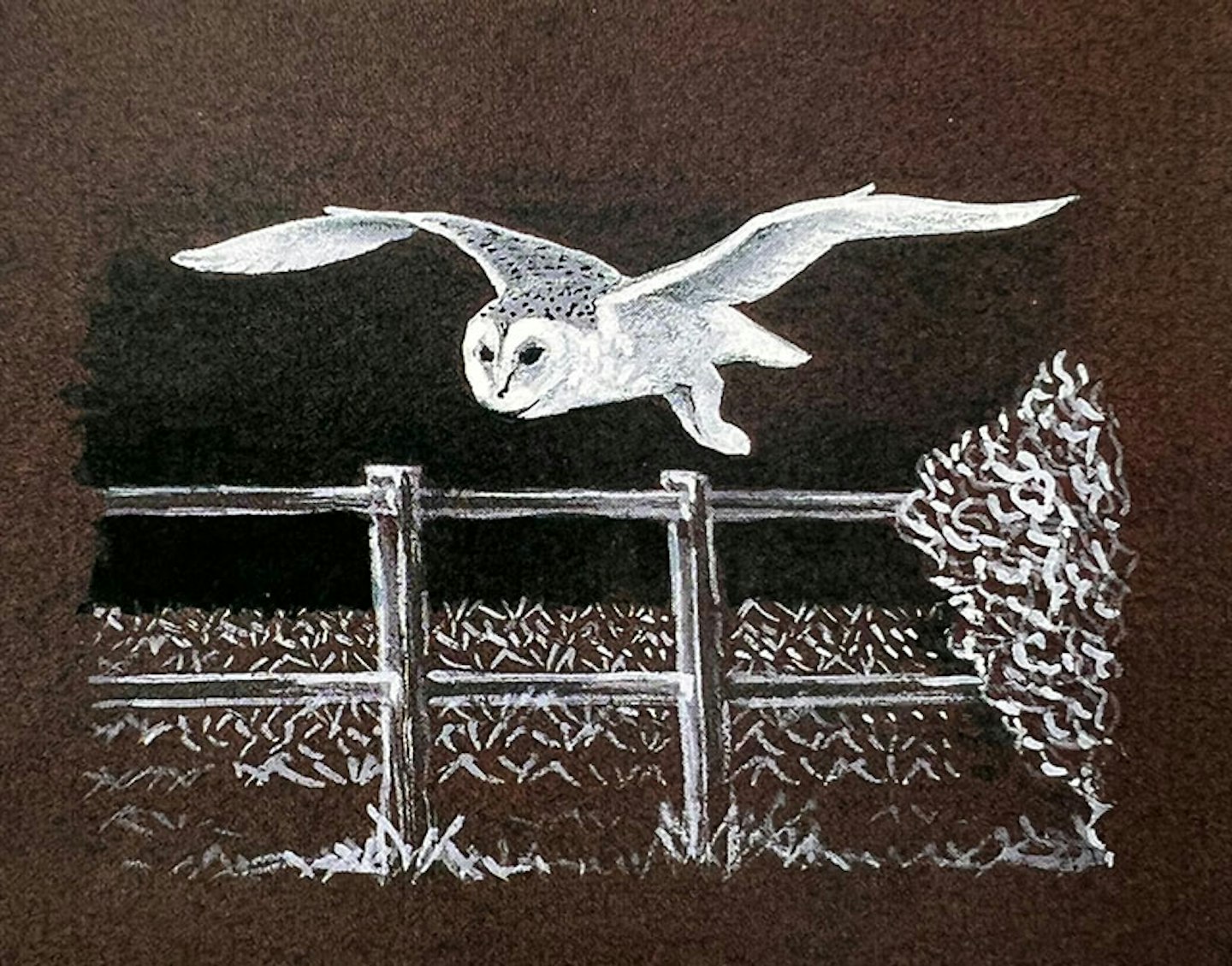
Reading my 26 year-old log of our goose hunt, I have to admit to a twinge of guilt over the way that we stalked our targets in the absence of any cover, let alone a hide. I would not do so now and yet I still miss the the challenge of pitting my fieldcraft against the wariest of birds. Ah, well, I can’t have everything!
The best modern substitutes for ancient ditch-crawling are either to find a goose ground interlaced with quiet roads (and use your car as a stalking horse) or to watch an evening arrival at a roost.
The best “free range areas” that I know are between the Ythan and Strathbeg in Grampian; Islay; the whole Solway/Borders region; Loch Leven; Lancashire; and particularly the south-west Irish coast, the last decorated by superb pale-bellied Brents.
For incoming roost flights that are really dramatic, try Bridgend on Islay and Gladhouse reservoir south of Edinburgh – Barnies at the first, Pinks at the second!
